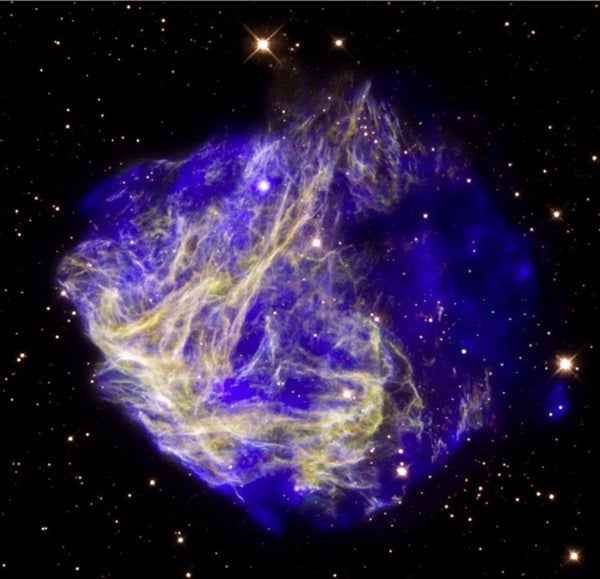This beautiful composite image shows N49, the aftermath of a supernova explosion in the Large Magellanic Cloud. A new long observation from NASA’s Chandra X-ray Observatory, shown in blue, reveals evidence for a bullet-shaped object being blown out of a debris field left over from an exploded star.
In order to detect this bullet, a team of researchers led by Sangwook Park of Penn State University used Chandra to observe N49 for over 30 hours. This bullet can be seen in the bottom right-hand corner of the image. This object is rich in silicon, sulphur, and neon. The detection of this bullet shows that the explosion that destroyed the star was highly asymmetric.
The bullet is traveling at a high speed of about 5 million mph (8 million km/h) away from a bright point source in the upper-left part of N49. This bright source may be a so-called soft gamma repeater (SGR), a source that emits bursts of gamma rays and X-rays. A leading explanation for these objects is that they are neutron stars with extremely powerful magnetic fields. Because neutron stars are often created in supernova explosions, an association between SGRs and supernova remnants is not unexpected. This case is strengthened by the apparent alignment between the bullet’s path and the bright X-ray source. However, the new Chandra data also shows that the bright source is more obscured by gas than expected if it really lies inside the supernova remnant. In other words, it is possible that the bright X-ray source actually lies beyond the remnant and is projected along the line of sight. Another possible bullet is located on the opposite side of the remnant, but it is harder to see in the image because it overlaps with the bright emission from the shock-cloud interaction.
Optical data from the Hubble Space Telescope (yellow and purple) shows bright filaments where the shock wave generated by the supernova is interacting with the densest regions in nearby clouds of cool, molecular gas.
Using the new Chandra data, the age of N49, as it appears in the image, is thought to be about 5,000 years, and the energy of the explosion is estimated to be about twice that of an average supernova. These preliminary results suggest that the original explosion was caused by the collapse of a massive star.










